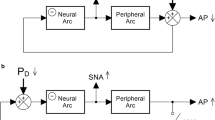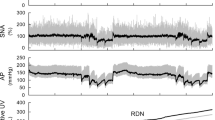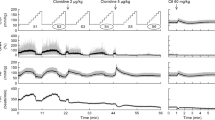Abstract
Stimulus-response curves relating renal-venous-arterial plasma renin activity difference (P.R.A.-difference) to mean renal artery pressure (R.A.P.) were studied in seven chronically instrumented conscious foxhounds with a daily sodium intake of 6.1 mmol/kg. R.A.P. was reduced in steps and maintained constant for 5 min using an inflatable renal artery cuff and a pressure control system.
The stimulus-response curve obtained during control conditions (C) or during common carotid artery occlusion (C.C.O.) could be approximated by two linear sections: a rather flat section or plateau-level of P.R.A.-difference at normal blood pressure or above, and a very steep section between a distinct threshold pressure and 65–70 mm Hg. While the parameters of the curves varied from dog to dog, the curves kept their inique shape in the individual dog for at least 1 week. C.C.O. had no effect on the plateau-level of the P.R.A.-difference (C:0.98±0.14,C.C.O.:0.99±0.14 ng Al·ml−1·h−1) and on the slope of the curve below threshold pressure (C:−0.379±0.041,C.C.O: −0.416±0.082 ng Al·ml−1·h−1·mm Hg−1) but shifted the stimulus-response curve to the right and increased threshold pressure (C:92.7±2.8,C.C.O.:109.7±4.1 mm Hg;P<0.05).
Renal blood flow, which was measured simultaneously in three of the dogs, showed good autoregulation down to 70 mm Hg under resting conditions and was not affected by C.C.O. except for a 30% reduction of renal blood flow at the lowest pressure step (70 mm Hg).
β-Adrenergic blockade in 4 of the dogs reduced the plateau-level of the P.R.A.-difference from 0.86±0.19 to 0.36±0.05 ng AI·ml−1·h−1 (P<0.05) but had no effect on the increase of threshold pressure elicited by C.C.O.
It is concluded that the stimulus-response curve for the pressure-dependent renin release has a remarkable long-term stability in the individual dog. The curve is shifted to the right by a moderate carotid baroreflex increase of renal sympathetic nerve discharge which leaves total renal blood flow largely unchanged. It is suggested that the increase in threshold pressure is independent of β-adrenergic effects.
Similar content being viewed by others
References
Abe Y, Dixon F, McNay JL (1970) Dissociation between autoregulation of renal blood flow and glomerular filtration rate. Am J Physiol 219:986–993
Blaine EH, Zimmermann MB (1970) Renin secretion during dynamic changes in renal perfusion pressure. Am J Physiol 236:F546–F551
Blair ML (1983) Stimulation of renin secretion by α-adrenoceptor agonists. Am J Physiol 244:E37–E44
Cowley AW, Guyton AC (1972) Quantification of intermediate steps in the renin-angiotensin-vasoconstrictor feedback loop in the dog. Circ Res 30:557–566
Davis JO, Freeman RH (1976) Mechanisms regulating renin release. Physiol Rev 56:1–56
Echtenkamp SF, Davis JO, Freeman RH, Dietz JR, Villareal D (1983) Splanchnic and renal contributions to circulatory homeostasis in sodium depletion. Am J Physiol 245:H573–H579
Eide I, Løyning E, Kiil F (1973) Evidence for hemodynamic autoregulation of renin release. Circ Res 32:237–245
Farhi ER, Cant JR, Barger AC (1982) Interaction between intrarenal epinephrine receptors and the renal baroreceptor in the control of PRA in conscious dogs. Circ Res 50:477–485
Farhi ER, Cant JR, Barger AC (1983) Alterations of renal baroreceptor by salt intake in control of plasma renin activity in conscious dogs. Am J Physiol 245:F119–F122
Finke R, Gross R, Hackenthal E, Huber J, Kirchheim H (1983) Threshold pressure for the pressure-dependent renin release in the autoregulating kidney of conscious dogs. Pflügers Arch 399:102–110
Freeman RH, Davis JO, Villareal D (1984) Role of renal prostaglandins in the control of renin release. Circ Res 54:1–9
Gibbons GH, Dzau VJ, Farhi ER, Barger AC (1984) Interaction of signals influencing renin release. Ann Rev Physiol 46:291–308
Gross R, Kirchheim H (1980) Effects of carotid occlusion and auditory stimulation on renal blood flow and sympathetic nerve activity in conscious dogs. Pflügers Arch 383:233–239
Gross R, Kirchheim H, Brandstetter K (1976) Basal vascular tone in the kidney. Evaluation from the static pressure-flow relationship under normal autoregulation and at maximum dilation in the dog. Circ Res 38:525–531
Gross R, Ruffmann K, Kirchheim H (1979) The separate and combined influence of common carotid occlusion and nonhypotensive hemorrhage on kidney blood flow. Pflügers Arch 379:81–88
Gross R, Hackenberg HM, Hackenthal E, Kirchheim H (1981) Interaction between perfusion pressure and sympathetic nerves in renin release by carotid baroreflex in conscious dogs. J Physiol (Lond) 313:237–250
Guazzi MD, Fiorentini C, Olivari MT, Bartorelli A, Magrini F, Biancardi C (1981) Circulatory and renin response in man to unilateral reduction of the renal perfusion pressure. Cardiovasc Res 15:637–642
Gutmann FD, Tagawa H, Haber E, Barger AC (1973) Renal artery pressure, renin secretion and blood pressure control in trained dogs. Am J Physiol 244:66–72
Guyton AC, Manning RD Jr, Hall JE, Norman PA Jr, Young DB, Pan Y (1984) The pathogenic role of the kidney. J Cardiovasc Pharmacol 6 (suppl I): S151-S161
Hackenthal E, Hackenthal R, Hofbauer KG (1977) No evidence for product inhibition of the renin-angiotensinogen reaction in the rat. Circ Res 41 (suppl II): 49–54
Holdaas H, Langård Ø, Eide I, Kiil F (1981) Mechanism of renin release during release during renal nerve stimulation. Scand J Clin Lab Invest 41:617–624
Katholiy RE (1983) Renal nerves in the pathogenesis of hypertension in experimental animals and in humans. Am J Physiol 245:F1-F14
Keeton TK, Campbell WB (1980) The pharmacologic alterations of renin release. Pharmacol Rev 32:81–227
Kiil F (1975) Influence of autoregulation on renin release and sodium excretion. Kidney Int 8 (suppl.):208–218
Kirchheim H, Gross R, Hackenberg HM, Hackenthal E, Huber J (1981) Autoregulation of renin release and its modification by renal sympathetic nerves in conscious dogs. Kidney Int 20 (Abstract):152
Kopp UC, DiBona GF (1984) Interaction between neural and nonneural mechanisms controlling renin secretion rate. Am J Physiol 246:F620-F626
Langård Ø, Holdaas H, Eide I, Kiil F (1981) Conditions for humoral α-adrenoceptor stimulation of renin release in anaesthetized dogs. Scand J Clin Lab Invest 41:527–534
Øien AH, Aukland K (1983) A mathematical analysis of the myogenic hypothesis with special reference to autoregulation of renal blood flow. Circ Res 52:241–252
Olson RD, Nies AS, Gerber JG (1983) Catecholamine-induced renin release in anaesthetized mongrel dog is due to both alpha and beta adrenoceptor stimulation: evidence that only the alpha adrenoceptor component is prostaglandin mediated. J Pharm Exp Ther 224:483–488
Oster P, Bauknecht H, Hackenthal E (1975) active and passive immunization against angiotensin II in the rat and rabbit. Evidence for a normal regulation of the renin-angiotensin-system. Circ Res 37:607–614
Skinner SL, McCubbin JW, Page IH (1964) Control of renin secretion. Circ Res 15:64–76
Taugner R, Hackenthal E, Nobiling R, Harlacher M, Reb G (1981) The distribution of renin in the different segments of the arterial tree. Immunocytological investigations in the mouse kidney. Histochemistry 73:75–88
Vikse A, Holdaas H, Hartmann A, Kiil F (1983) Segmental distribution of vascular resistances during ureteral occlusion. The vasoconstrictive effects of angiotensin and CaCl2 differ from those of catecholamines and renal nerve stimulation. Acta Physiol Scand 119:147–158
Wiegman DL, Steinhausen M, Parekh N (1984) Differential adrenergic control of the renal microcirculation. Int J Microcirc Clin Exp (Abstract) 3:312
Author information
Authors and Affiliations
Additional information
This study was supported by the German Research Foundation within the SFB 90, Heidelberg
A priliminary part of this investigation has been presented to the meeting of the German Physiological Society, Dortmund, March 1984 [Pflügers Arch (1984) suppl 400:R11,41]
Rights and permissions
About this article
Cite this article
Kirchheim, H.R., Finke, R., Hackenthal, E. et al. Baroreflex sympathetic activation increases threshold pressure for the pressure-dependent renin release in conscious dogs. Pflugers Arch. 405, 127–135 (1985). https://doi.org/10.1007/BF00584533
Received:
Accepted:
Issue Date:
DOI: https://doi.org/10.1007/BF00584533




